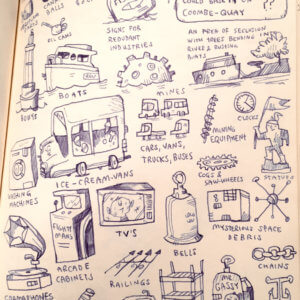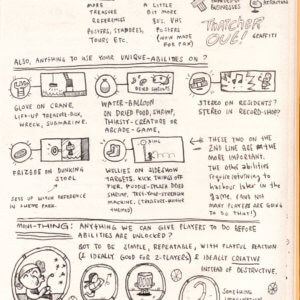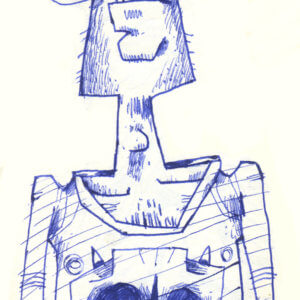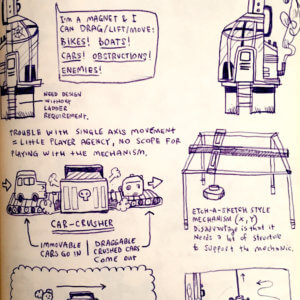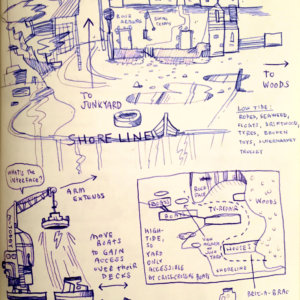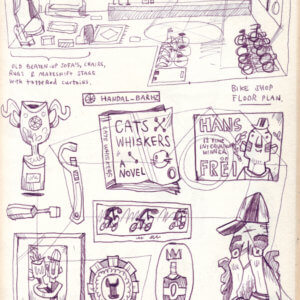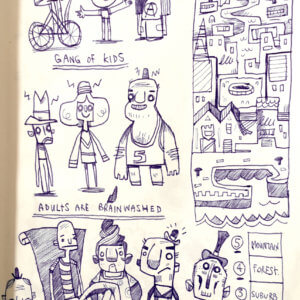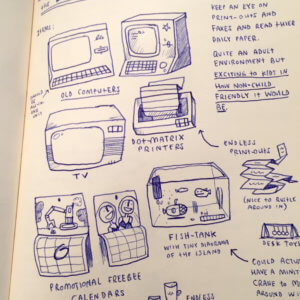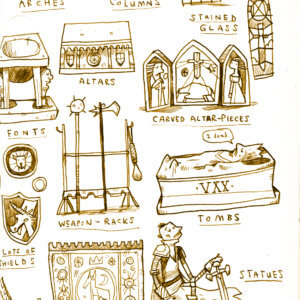Interview with ‘Knights and Bikes’ co-creator Rex Crowle
Peddling furiously across the drizzly island of Penfurzy in Cornwall, two young girls battle their way through bizarre and unusal happenings to find treasure and save their community, all whilst having a great time!

Created by Rex Crowle (LittleBigPlanet, EpicWin) and Moo Yu (LittleBigPlanet, Ring Fling and MonstrosCity) of Foam Swords, Knight and Bikes is a beautifully animated new game that brings together childhood imagination and a thirst for exploration. Boasting organic textures and lovingly-constructed colour palettes, the project has intrigued gamers and animation fans alike since it began its life as a crowdfunding campaign. The world that Foam Swords have created for their central characters Demelza and Nessa to play amongst is truly a delight, bringing together characterful design, dynamic animation and varied gameplay.
As a game it succeeds, but on a visual level Knights and Bikes excels, giving the feeling of a particularly gorgeous short film or TV series that you happen to be able to interact with and explore to your heart’s content, which in and of itself feels like a childhood dream come true. Amongst battles with cursed librarians, treks through hippo-infested mud swamps and the ability to customise your very own bicyle, the game also features multiplayer options and interactivity between the characters’ various tools and power-ups, offering a great social gaming experience best played inside on a drizzly day in your PJs.
The game itself has been on a hell of a journey to get to its release date last month and is now available on Steam, PS4 and GOG. The game even has a couple of tie in-books created by Gabrielle Kent that allow you to explore the lives of the central chacters even further and contine the adventure after lights out. We took the opportunity to talk to co-creater and creative lead Rex Crowle about the game’s creation.
Can you tell me a little about how you and Moo met, and why you’re called Foam Swords?
We originally met at a studio called Media Molecule, where we both worked on a game called LittleBigPlanet, a game that introduced the character Sackboy to the world, and allowed players to play and make their own games and share them with all Playstation players, a particularly revolutionary concept at the time!
I’d been at that studio since its founding, working on the companies branding along with the games art and design (along with my own animated short films). Moo joined the studio shortly afterwards, travelling over from his native California, where he’d been working for Insomniac Games on the Ratchet And Clank games as a gameplay programmer.
After LittleBigPlanet we went separate ways, Moo left for new challenges in mobile and social games, I stayed at Media Molecule to direct a game called Tearaway. But we then joined back up to make a smaller scale project with our own company Foam Sword.
The name Foam Sword references imaginative play. It’s meant to conjure thoughts of dressing-up, of make-believe and the kind of heroic games kids will play, even if all they have is a cardboard-box and a mop. Some of the other company names we considered were Box-Fort, Naughty Step and Bouncy Castle!
Can you tell me a little about how long you’ve been developing this game and what inspired the idea?
The initial inspiration for the game and its themes came from coming-of-age movies, particularly from the 1980s, films like The Goonies. Those movies where kids that are pushing at the boundaries of their childhood experience, rebelling a little from their parents, finding their own identities but within the framework of a grand treasure-hunting adventure. The easy option for us would have been to just make a direct homage to that film, but that wouldn’t have been so creatively rewarding to develop, nor as surprising and memorable to players. So the final game is more of a blend, the classic relatable feelings of being a kid, getting your first bike and using it to gain independence, but with a very specific and unusual setting to give players something new.
In terms of time, the game has been around for several years, initially as a little hobby project between the two of us. Personally, I wanted to get more hands-on for a while and learn new techniques after spending the previous five years directing a much larger project and team. So Moo and I would get together and tinker with our little experiment, and try out different styles of gameplay, but as a very casual weekend project. When it felt like it was forming into something larger we decided to bring it to Kickstarter in the spring of 2016, after a very busy six months of creating enough content to cut our original trailer from. And from then onwards we’ve just been trying to ensure we give everyone the game that we were pitching to them back then with just a trailer!
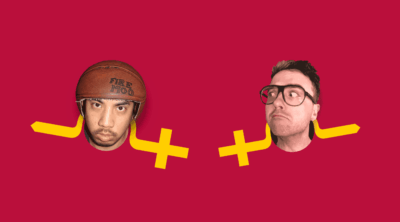
Moo Yu & Rex Crowle
The visuals and gameplay really conjure that feeling of childhood imagination, fantasy games and summer adventuring. I read that originally you were going to have more characters, why did you choose Nessa and Demelza in the end?
Yes, so part of that initial plan to make a Goonies-inspired game was to also replicate a whole gang of kids, and get all the interplay that happens between them. Pretty quickly we found that this wasn’t as compelling as we first thought. Firstly, it meant that instead of actually feeling like you were playing as a bunch of kids you felt disconnected – more like some kind of commander, or unseen force that was guiding them all. You actually felt more like the parental control that the kids would be trying to break free from!
Secondly, it meant that the kids were becoming more like gameplay tools for players to use, rather than fully formed characters. The geeky kid could use computers, the sports jock was powerful and so on. All very useful, but it was hard to really connect with them, or make the most of their personalities. So we ended up cutting most of our initial cast so we could focus on the two characters we liked the most, the two that were the least stereotypical, and had the most interesting dynamic between them. Firstly, Demelza, the imaginative dreamer who’s slightly withdrawn into her world of make-believe since the death of her mother. And she’s accompanied with Nessa, a slightly older, more worldly stowaway who mysteriously arrives at Demelza’s door.

Knights & Bikes
Who were the two lead heroines based on, if anyone?
Demelza is definitely a combination of a lot of the girls I went to primary school with. Although there were only 26 children in my local school, most of them were actually called Demelza. There’s probably a little bit of me in there too, and that’s not just the teeth!
Nessa comes from outside the island, she’s a person of colour who has traveled from much further away and has a wider range of influences. But I guess if I had to pin something down I’d say that there’s some of the rebellious spirits of a very young Winona Ryder there, she’s representing more of a punky coolness in the duo. She also has the same haircut and attitude as my girlfriend!
The style is what really drew me to the game, I hadn’t seen anything quite like it and as both a 2D and stop-motion animator it really spoke to me. You’ve mentioned before that you based the movement on the mechanics of stop-motion can you explain this a little more?
Thanks! It’s a blend of several different techniques throughout the game, but I’ll just focus on the main characters here. They are rigged and animated in some 2D software called Spine. The results of that were a little too smooth for the handpainted style of the game so elements of traditional frame-based animation are also used on the characters, particularly with exaggerated line-boil.
It would have been nice to hand-animate everything given the painterly style, but with characters that have many different moves, each of which can be in up to 8 compass directions, and beholding different items at the time – well, it was too much both for the workload and the amount of computer memory required to store all the frames.
The biggest challenge was animating the bike-riding, which combines 4 separate animations along with some IK and a lot of tech to create the effect of cycling in 22 directions as piece of 2D-art but with moving in 3D in the scene. The end results are a little wonky but hopefully still conveys the joy of wildly pedaling your bike and then standing up on the pedals to coast downhill!
Your drawing style has a brilliant chaotic, energy, it is also very well-considered and designed, who has inspired your artistic and animation style?
The aim with the art-style was to take somewhere quite believable: a slightly run-down, economically challenged Cornish island, and then try and see that through the wild imaginative eyes of children.
To convey that, everything is painted in similar materials to what a child would also use to tell stories: pastels, chalk, poster-paint. But at the same time it needed to feel believable, not like you’re running around in an actual painting. So it’s a careful blend of the art materials used to create believable scenes but with more exaggerated perspectives and overlaid effects when their imagination starts to warp reality further.
I really love how children will draw the things that matter to them and leave out unimportant details. Characters with giant heads but without any arms. Or a building with all the details on the front, even though most of them should technically be reserved for the back. It’s the way they just want to share all the things that are most important to them. So I’ve definitely taken inspiration from that artistic energy, along with the paintings of Alfred Wallis, a Cornish fisherman turned painter who had a similarly naive style, but one that has kept me inspired to push away from the usual perspectives and representations of reality.
Animation-wise, the biggest influence was the work of Bob Godfrey and the anarchic chaos of his work on Rhubarb and Custard. It’s extreme use line-boil just made me go bananas when I saw repeats of it on TV as a kid. The levels of energy and excitement in those films were something I wanted to translate into Knights And Bikes, particularly in the character of Demelza. So the same line-boil style is visible in her curly red hair always buzzing around her head, as well as in anything else the stormy winds on the island are effecting like grass and flowers.
The gameplay is quite a mix -part RPG, part exploratory, with a lot of different elements to the way the two-characters interact with the world, each other and themselves. How did you initially decide on what elements to bring into the game?
It was fairly freeform in how it came together. We knew we wanted to represent that feeling that it’s the last week of the school holidays and you just want to get outside and fit as much as you can in before having to return to reality and school. So a lot of the game is running from one situation to the next as a pair of excitable kids, spurring each other on in this grand treasure hunt. But behind the scenes, I’ve gone through with lots of reordering of events to try and bring satisfying pacing and tell a more emotional story along the way.
Initially, the game was going to be more combat-focused, and although no humans or animals ultimately get hurt, it didn’t feel quite right to be running around the world hitting everything! So a lot of work went into giving you much more to do and allowing the ways you interact with the world to be more playful and experimental. As you play the game your characters are given certain key abilities, which are kind of like improvised weapons, like Frisbees and water-balloons. The important thing was to make sure there was a really good range of non-aggressive ways to use these items as well: to solve puzzles, to interact with each other, and with other characters in the game, so it felt joyful rather than in any way violent.
The final game can probably be divided fairly equal parts of puzzles, exploration, combat, and story-progression. And it’s mostly co-operative between both characters (and both players if you are playing it with a friend) but also with some fun little competitive challenges between players to mix it up a bit. We both had strong childhood memories of suddenly shouting out “Bet you can’t get to that tree before me!” and the entire world just dropping away as everything becomes about getting to that old oak before your friend does.
Ultimately, like with any project, you just have to have a strong goal of what the final piece is supposed to be about and then make sure everything within it is working toward that goal. So even if you have a wide variety of content and gameplay styles, it all feels part of the whole. And it makes it much easier to find things the right things to prune when you’re running out of time and budget!

Knights & Bikes
What were the biggest obstacles?
A really tiny team. We’re both hard workers, but with the game having a lot of different ways to interact with it, online co-op play, and being so heavy in visual content it’s not always been easy. Its development has certainly taken it’s a toll on me, and I’m ready for an almost permanent holiday now!
We probably showed the game a little too early on Kickstarter, so certain things that still needed a lot of experimentation were hard to budget or plan for. And without all the game-making tools in place, it was hard to know exactly how we’d tell the story we’d promised. All of those things got figured out along the way, but it was a much longer bumpier road than we might have expected. Luckily everyone kept their faith in us, from our publishers at Double Fine, to Kickstarter backers who were fantastically patient and encouraging.
You helped fund the project with Kickstarter, why was this and what do you feel you gained by funding the game this way?
It was a fun new thing to do, and very different from methods we’d been involved with before. From being in mobile-games Moo had seen more of the VC investor world, and I’d been so very grateful to all the support from Sony to fund my previous game Tearaway.
But now we were creating a game and company much smaller than those projects neither of us felt it would be quite right for the larger games publishers, nor was it right for VC investors that are motivated by the projected growth of your company. We didn’t want to be expanding our offices and hiring lots of staff, we wanted to carry on tinkering on our project on the kitchen table!
Kickstarter felt like a fun option for a more hand-made project because we could really take our backers on the journey with us. We felt that crowdfunding could create more of a community around the game, and to give us some other people to share progress, and celebrate the highs and lows with, which was important being such a tiny team.
Again, it was a lot of work, particularly during the initial 1-month-long campaign to create all the assets to keep the funding coming in, but it was also fun and exhilarating. I definitely enjoyed using my old marketing skills as much as my design ones during that process to create box-art, t-shirts, short-films and anything else that might help get our project crowdfunded.
And as the project has gone on, doing the monthly backer-updates has been really good. They give a bit of structure to a project with a multi-year development. You’re always making sure you have a good range of new things to show by the end of the month, as well as getting feedback and responses from sharing the progress.
If you’re going to do a Kickstarter, my number one recommendation is to keep up good and regular communication with your investors. It’s good for you and it’s good for your backers!

Knights & Bikes
The music I remember was a big part of the Kickstarter, you worked with Kenny Young and Daniel Pemberton for the sound and music, what did you initially want for the sound and how did this collaboration bring that together?
Both Kenny and Daniel we’ve worked with before and have a good creative chemistry with. As well as leading the audio department at Media Molecule Kenny was also very involved in writing the narrators scripts and story with me on Tearaway, so I knew he’d definitely be fantastic to have around on the project as much as possible, with or without his audio design skills! Kenny has really developed the audio-experience of the project not just to include the sounds you’d expect to hear, but also bringing in the more fantastical element too. Those times when our heroine’s imaginations are getting carried away, and you’ll start to hear ancient chanting in the background, or the sound of knights on horseback, or possibly a distant dragon. All of which gives the exploration a very different atmosphere and inspires us to add more visuals or interactions to catch up!
Daniel is also a very good and very talented old friend, who these days is mostly composing for giant Hollywood productions like Spider-Man: Enter The Spider-Verse or the new Dark Crystal series. So we were very lucky to get some of his time for our bicycle adventure! Much like the overall development of the project, some of the initial musical thoughts were more closely in the 1980s pastiche territory, but Daniel had some more interesting ideas. He wanted to go for a more timeless atmosphere for much of the score, more similar to Carl Orff and the atmosphere of childlike wonder he created in his work. Ultimately Daniel pulled together a number of different moods and themes for our crowdfunding video, which had so many different musical phases I think of it like the Bohemian Rhapsody of Kickstarter videos! And that range continued with the rest of the score: moving from more ominous John Carpenter synths to the most raucous punk track you’ve probably ever heard in a video game, and all sung by an 8-year old!
What are your plans for the game now?
At the moment we’re focused on supporting our launch and all the new players that are diving into the game every day. Humans are very creative and unique in the way they each play. So they often do things you don’t expect (which is just what we hope for) but it can occasionally uncover a bug or two. So Moo has been making sure those all get fixed as they are reported. It’s not many players that will experience them, especially now most are fixed, but we want to make sure it’s the same smooth experience for everyone, no matter their level of game playing skill or tech knowledge.
Outside of the game, we already have two Knights And Bikes books, published by Knights-Of, and brilliantly written by Gabrielle Kent, so hopefully, that series will continue to develop. We certainly take a lot of enjoyment from reading about all the extra adventures that Nessa and Demelza are going on!
Apart from that it’s mainly working on new merchandise for existing fans and looking at ways to bring new players into our world, or new opportunities to do extra things with it.
Knights and Bikes is available now on PS4, Steam and GOG. See more of the work of Foam Swords at foamswordgames.com


